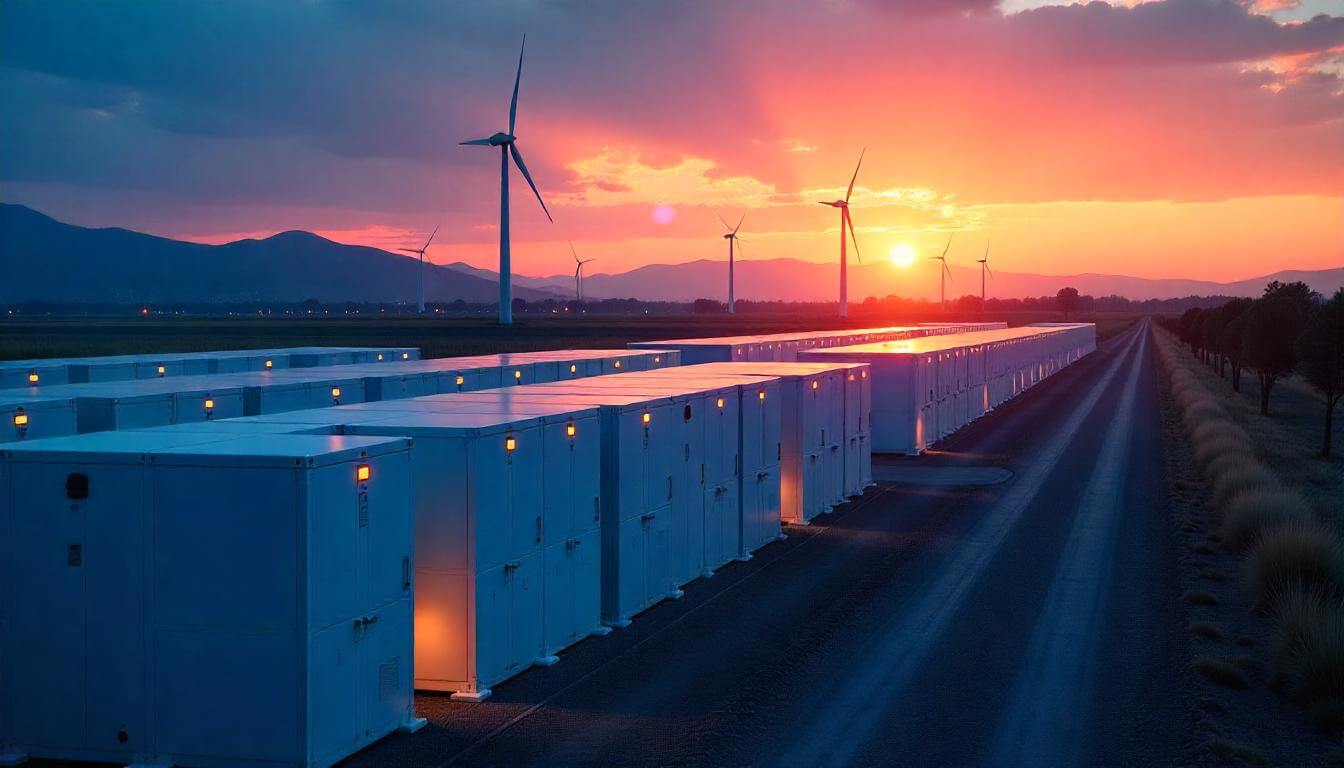The global transition to a sustainable energy future hinges not just on generating clean power, but on effectively storing it. Renewable sources like solar and wind are inherently intermittent; the sun doesn’t always shine, and the wind doesn’t always blow. Energy storage solutions are the crucial bridge, ensuring a consistent and reliable supply of clean electricity. A recent $55 million energy storage deal, spearheaded by the investment firm CVFF, marks a significant step forward in this critical area. This substantial investment is set to accelerate the deployment of advanced energy storage technologies, promising a major win for sustainability by stabilizing grids, integrating more renewables, and ultimately reducing carbon emissions. This article examines a significant financial transaction (over $50 million) that is powering a greener tomorrow.
The Intermittency Challenge: Why Storage is Essential
The rapid growth of renewable energy capacity has brought unprecedented benefits to the fight against climate change. However, it also presents a fundamental challenge: variability. Solar panels produce electricity only during daylight hours, peaking around noon, while wind turbines generate power only when the wind blows. This natural fluctuation often does not align with peak electricity demand, leading to imbalances in the grid. Without effective storage, excess renewable energy might be curtailed, or fossil fuel “peaker” plants might be fired up to meet demand spikes, undermining the environmental benefits.
Therefore, energy storage systems are no longer a luxury; they are an absolute necessity. They decouple the timing of electricity generation from consumption. They ensure that clean energy produced during periods of abundance can be saved and dispatched precisely when needed. This capability is vital for creating a truly resilient and sustainable energy infrastructure.
The Power of Energy Storage: Beyond Batteries
While lithium-ion batteries are often synonymous with energy storage, the sector encompasses a diverse array of innovative technologies. Large-scale solutions range from pumped-hydro storage, which uses gravity to store energy by moving water between reservoirs, to compressed air energy storage (CAES), which uses excess electricity to compress air into underground caverns. Thermal energy storage captures heat or cold, and even flywheels store kinetic energy. Each technology offers unique advantages in terms of duration, capacity, and cost, catering to different grid needs.
Moreover, advancements are continuously being made in battery chemistry, including flow batteries and solid-state batteries, which promise greater longevity, safety, and energy density. This technological diversity ensures that the grid can adopt the most suitable storage solution for any given application. It therefore maximizes efficiency and effectiveness in supporting renewable integration.
CVFF’s $55 Million Energy Storage Deal: Fueling Grid Transformation
CVFF’s $55 million energy storage deal has been directed towards “GridFlex Solutions,” a company specializing in deploying modular, grid-scale battery energy storage systems (BESS). This strategic investment underscores CVFF’s commitment to supporting technologies that underpin the transition to a net-zero economy. The capital infusion will enable GridFlex Solutions to rapidly expand its project pipeline, enhance its proprietary energy management software, and penetrate new utility-scale and commercial markets across the globe.
This substantial backing will primarily fund the procurement and installation of new battery storage facilities. It will also support research and development into next-generation battery chemistries and advanced grid optimization algorithms. Ultimately, this deal positions GridFlex Solutions to become a key enabler of renewable energy integration and grid modernization, providing a scalable answer to the intermittency challenge.
Integrating Renewables: Making Green Energy Reliable
A primary environmental benefit of this $55 million energy storage deal is its direct contribution to integrating higher percentages of variable renewable energy into national grids. Energy storage systems serve as crucial buffers. They store surplus solar power generated on sunny days and excess wind energy produced on windy nights. This stored energy is then dispatched during periods of low renewable output or high demand. This ensures a consistent and reliable supply of clean power, regardless of weather conditions.
Consequently, utilities can rely more heavily on renewables. They reduce their dependence on fossil fuel-fired power plants. This “smoothing” effect of energy storage prevents the curtailment of renewable energy, ensuring that every electron generated from clean sources is effectively utilized. It therefore maximizes the environmental impact of solar and wind installations, pushing towards a truly decarbonized energy mix.
Enhancing Grid Stability and Resilience
Beyond facilitating renewable integration, the investment in energy storage significantly enhances grid stability and resilience. Modern electricity grids, designed for centralized fossil fuel generation, struggle with the rapid fluctuations of intermittent renewables. Energy storage systems, particularly batteries, offer fast-responding power reserves. They help to balance supply and demand fluctuations instantaneously. This means the grid can more effectively handle sudden drops or surges from renewable sources.
Furthermore, these systems provide critical backup power during grid disruptions. They act as a buffer during extreme weather events or equipment failures. This capability is vital for maintaining uninterrupted power to consumers and critical infrastructure. The $55 million energy storage deal therefore strengthens the entire energy network, making it more robust against unforeseen challenges.
Displacing Fossil Fuel Peaker Plants
Another significant sustainability win enabled by this energy storage deal is the displacement of “peaker” power plants. These are typically less efficient and more polluting natural gas or diesel facilities. They are traditionally brought online only during periods of peak electricity demand or when renewable generation dips. Their quick-start capabilities fill immediate supply gaps.
However, energy storage can now provide the necessary power during these peak times. This directly displaces the need for environmentally detrimental peakers. By storing cheaper, clean energy during off-peak hours and discharging it during peak demand, energy storage systems offer a cleaner, more flexible, and often more cost-effective alternative. This directly translates to reduced greenhouse gas emissions and improved local air quality, particularly in communities often burdened by emissions from these plants.
Economic Benefits and Job Creation
The environmental advantages of energy storage are clear, but the economic benefits are equally compelling. The $55 million energy storage deal will stimulate significant economic activity. It will create new jobs in manufacturing, installation, operation, and maintenance of energy storage systems. This boosts local economies and fosters a skilled green workforce.
Moreover, energy storage can lead to substantial cost savings for utilities and consumers alike. By storing low-cost energy during off-peak hours and discharging it during peak pricing, storage enables “energy arbitrage,” reducing overall electricity costs. It can also defer the need for costly upgrades to transmission and distribution infrastructure by strategically managing grid congestion. Ultimately, the deployment of energy storage systems represents a sound financial investment that yields both environmental and economic returns.
The Path Forward: Scaling for Greater Impact
While the $55 million energy storage deal is a substantial investment, the path to a fully sustainable grid requires continuous scaling and innovation. Challenges include the upfront capital costs of large-scale projects, the need for supportive regulatory frameworks, and ensuring a secure and sustainable supply chain for battery raw materials. However, the momentum behind energy storage is undeniable.
Ongoing research and development are focused on improving battery lifespan, reducing costs further, and exploring alternative, more sustainable chemistries. The integration of energy storage with smart grid technologies and advanced forecasting will further optimize its performance. Policy support, through incentives and clear market signals, will also be crucial to accelerate widespread adoption. The commitment demonstrated by this deal provides a strong signal to the market.
Conclusion: A Transformative Investment in Our Planet
CVFF’s $55 million energy storage deal stands as a powerful testament to the critical role of energy storage in achieving global sustainability goals. By enabling the broader deployment of advanced energy storage solutions, this investment directly addresses the intermittency of renewable energy, enhances grid stability and resilience, and actively displaces polluting fossil fuel peaker plants. This strategic capital infusion is not merely a financial transaction; it is a profound investment in a cleaner, more reliable, and ultimately, more sustainable energy future for all. It underscores that by strategically combining renewable energy generation with robust energy storage, we can truly unlock the full potential of clean power and combat climate change effectively.



コメント